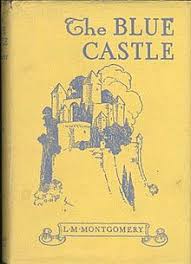Rediscovering The Blue Castle
Listen to the Recess! Clip
| Author | Catherine Tosenberger |
| Air Date | 11/30/2005 |

Rediscovering The Blue Castle Transcript
On this day in 1874, Canadian author Lucy Maud Montgomery was born in Clifton, Prince Edward Island. Montgomery is famous for her series about Anne of Green Gables, but today, I wish to pay tribute to one of her lesser-known, but equally powerful novels: The Blue Castle, published in 1926. It is unique in being the only Montgomery novel to take place wholly outside her beloved Prince Edward Island. Fans of The Blue Castle tend to see themselves as privy to a delightful secret, hidden from the casual readers of the monumentally popular Anne series; almost every one of the more than one hundred reader reviews on Amazon.com names The Blue Castle “Montgomery’s best book,” and speaks of rereading the novel multiple times – it’s a classic comfort book.
Heroine Valancy Stirling is 29 years old and unmarried, and therefore an object of ridicule and contempt. Alternately ignored and tormented by her cruel family, Valancy has grown up timid and cowed. When she discovers that she has a terminal heart ailment and only a year left to live, she throws off her fear and decides to enjoy the limited time left to her. To her family’s chagrin, she leaves home to nurse a disgraced former schoolmate, Cecilia Gay, who is dying of consumption after having borne an illegitimate child. That Cecilia’s father is the local handyman, and a cheerful drunk to boot, piles insult on top of injury for Valancy’s offended clan. In addition, she befriends mysterious stranger Barney Snaith; after Cecilia’s death, Valancy proposes marriage to him, and he accepts. They retreat to an idyllic home deep within the woods of the Muskoka region of Ontario. However, Barney is likewise fleeing a troubled past. All ends happily, of course, and while certain plot twists may strain credulity, the end result is deeply satisfying.
The Blue Castle was Montgomery’s first novel aimed at adults, which enabled her to tackle such controversial issues as Cecilia’s out-of-wedlock pregnancy, Abel Gay’s alcoholism, and Valancy’s own sexual desire, more than she did in her children’s novels. Valancy’s loneliness and frustration is a bitter thing, and the gently biting wit of the Anne books gives way to ferocious social satire: the family picnic where Valancy finally lets her relatives know exactly what she thinks of them is not only grand comedy, but also a lancing of a wound. Valancy rejects the Stirlings’ stifling bourgeois morality by allying herself with first Abel and Cecilia, and then Barney, all of whom have been ostracized by what Valancy calls the “little snobocracy.” And even though the ending lets the Stirling clan off lightly, Valancy, and Montgomery, are still, as one of Valancy’s sharper cousins sniffs, “laughing at them all in her sleeve.”
Though The Blue Castle is unabashedly sentimental, it is never mawkish; Montgomery’s acid sense of humor is given freer reign here than in any of her other books. The palpable anger of the early pages makes Valancy’s eventual liberation all the sweeter. The Blue Castle is a fierce, wickedly funny, and ultimately healing fairy tale, and like a fairy tale, readers keep returning to it again and again, recapturing the magic.